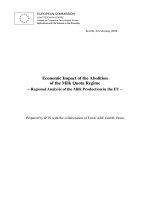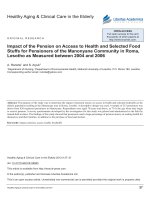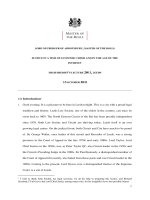Prevalence of the beta case in variants among Tharparkar, Rathi, Sahiwal, Kankrej and cross breed and its influence under selective pressure
Bạn đang xem bản rút gọn của tài liệu. Xem và tải ngay bản đầy đủ của tài liệu tại đây (308.22 KB, 7 trang )
Int.J.Curr.Microbiol.App.Sci (2019) 8(3): 1842-1848
International Journal of Current Microbiology and Applied Sciences
ISSN: 2319-7706 Volume 8 Number 03 (2019)
Journal homepage:
Original Research Article
/>
Prevalence of the Beta Case in Variants among Tharparkar, Rathi, Sahiwal,
Kankrej and Cross Breed and its Influence under Selective Pressure
Mrinalini Saran1*, Ankita Gurao1, Rajeev Kumar Joshi2 and S.K. Kashyap1
1
Department of Veterinary Microbiology and Biotechnology, 2Department of Animal Genetics
and Breeding, RAJUVAS, Bikaner, India
*Corresponding author
ABSTRACT
Keywords
Beta-casein, A2
type milk, Crossbred, Bos indicus
Article Info
Accepted:
15 February 2019
Available Online:
10 March 2019
Milk has been regarded as wholesome food since centuries. The major milk proteins are
the casein (80%) and the whey proteins (10%). One of the prominent milk proteins in
cattle i.e. beta casein, is encoded by highly polymorphic genes, leading to formation of 12
protein variants. Among them A1 and A2 variant are the most frequent; the A2 being the
primitive type present in Bos indicus at higher percentage than Bos taurus. Most of the
indicine cattle breed is A2 type carrying presence of histidine in A1 in contrast to proline
in A2 makes it susceptible to gastrointestinal proteolysis digestion to release betacasomorphin-7 (BCM-7), which has been implicated in various human health ailments.
The following study has been conducted to concisely predict the diminishing percent of A2
allele in the cross-bred Rathi cattle herd in compared to the pure-bred Rathi and other
indigenous cattle and evaluate the change in A2 allele frequency in course of generations.
Introduction
Milk has been regarded as a wholesome food
and also an essential part of diet for both
infants and adults. Worldwide the major
sources of milk are cow, buffalo, goat, sheep
and camel, contributing 85%, 11%, 2%, 1.4%
and 0.2% of world milk production
respectively. Cow contributes highest to the
milk production i.e. 600 million tonnes (83%
of total milk produced) (1) of milk every year
and with a herd capacity of total 264 million
worldwide (1). The total milk production in
India is highest in the world, approximately
182.16 million tonnes (2), 178 million cattle
population. The world per capita milk
availability was 322 gm/day (3) during 201415. Like any other developing country, the
fluid milk consumption of India is higher than
world average, thus again indicating the
necessity to focus on milk consumption
related health aspects.
The widely consumed cow milk has protein
content ~32 g/l, that forms the major portion
of protein in diet of infants and lactovegetarians next to the legumes. The casein
(80%) is abundant among the protein fraction,
comprising α-casein (29%), β-casein (27%)
and κ-casein (10%). The gene coding for
1842
Int.J.Curr.Microbiol.App.Sci (2019) 8(3): 1842-1848
CSN2 gene (β-casein) is present on BTA-6.
Like all other milk proteins, beta -casein is
highly polymorphic. Total of 49 milk protein
variants have been reported by Farell et al.,
2004. Till now 12 genetic variants (A1, A2,
A3, B, C, D, E, F, H1, H2, I, G) have been
reported for beta casein(4). The most common
form of beta casein in dairy cattle breeds are
A1 and A2, while B is less common and A3, C
are rare (5). On the basis of their potential to
release beta casomorphin-7, beta casein
variants can be categorized as A1 type and A2
type, the previous one containing B,C,F,G and
D variants, whereas the later category contains
A3, E, D, H1, H2 and I (6). Among all the
mutations occuring on beta casein, at 67th
position of the protein a noteworthy mutation
has lead to replacement of proline by histidine.
The codon CCT (proline) was replaced by
CAT (histidine) leading to formation of
variant A2 and A1 respectively. Presence of
histidine at A1 in contrast to proline in A2
makes it susceptible to gastrointestinal
proteolytic digestion for releasing betacasomorphin-7 (BCM-7), which has been
implicated in not only the type I diabetes and
IHD (Ischaemic Heart Diseases) but also in
several other non communicable diseases like
SIDS (Sudden Infant Death Syndrome),
schizophrenia, autism, milk related allergies
(7)
and
arteriosclerosis
(8).
The
epidemiological, in vivo and in vitro studies
have concluded with both positive (9,10) and
negative correlation (11) of the A1/A2 milk
consumption to the alleged health issues., This
mutation also carry an evolutionary
significance, the A2 being the primitive type
present in Bos indicus at higher percentage
than Bos taurus. The majority of taurine
breeds domesticated in America, Europe and
Australia (excluding Indian sub-continent,
most of the African zebu and few Far-East
countries) are taurine which has been bred
selectively for higher milk production, leading
to lower frequency of A2 allele (few
exceptions e.g. Guernsey and Fleckvieh
breed). Whereas the indicine cattle have
evolved naturally without any selection
pressure; thus, allowing them to carry higher
frequency of A2 allele. The consumption of
the A1 type milk in European population has
been clearly associated with type I diabetes
(9,10,12,), ischemic heart disease (12,10) and
neurological disorders (13) by several
epidemiological
data.
The
following
investigation has been done to estimate the
diminishing A2 allele frequency among the
indigenous cattle and cross-bred Rathi cattle in
compared to the pure bred indigenous Rathi
breed. This will aid in planning the breeding
policies in future, so that the A2 gene pool
remain conserved in the indigenous herd.
Materials and Methods
For the purpose of this work, Rathi pure breed,
Sahiwal, Kankrej, Tharparkar and cross breed
(Rathi×Holstein Fresian) were obtained from
LRS (CVAS, Rajasthan University of
Veterinary and Animal Sciences, Bikaner),
LRS (Kodamdesar, Bikaner), LRS (Beechwal,
Bikaner) and LRS (CVAS, Rajasthan
University of Veterinary and Animal Sciences,
Bikaner)., All the cattle were free of mastitis
and blood was collected from juglar veins and
genomic DNA was extracted on the same day
using QIAamp® DNA mini kit (Qiagen). The
DNA was then taken for purity and
concentration check by the use of nanodrop
device.
The ACRS-PCR and PCR-RFLP was
performed using the primers described by Lien
et al., (1992) and McLachlan (2006)
respectively (14,15).
CASB67: 5’-CCTGCAGAATTCTAGTCTA
TCCCTTCCCTGGGCCCATCG-3’
CASB122:5’-GAGTCGACTGCAGATTT
TCAACATCAGTGAGAGTCAGGCCCTG3’
1843
Int.J.Curr.Microbiol.App.Sci (2019) 8(3): 1842-1848
Csn4F: 5’-CCTTCTTTCCAGGATGAACTC
CAGG-3’
Csndde4R: 5’-GAGTAAGAGGAGGGATGT
TTTGTGGGAGGCTCT-3’
The primers CASB67 and CASB122 have
been designed in such a way that so that upon
amplification a restriction site for a taqI
enzyme is created in the amplicon. The
primers (csn4F and csnDde4R) are designed to
amplify the beta casein’s exon 7th and
amplified product has the naturally occuring
restriction site for DdeI enzyme. The PCRRFLP was only used for amplifying Sahiwal
DNA. The PCR was performed by 200 ng of
genomic DNA in a 25 μl reaction volume
containing final volume of 5 pmol of primers,
200 μM of each dNTP and 1 U of Taq
polymerase (GoTaq® PCR Core System I
Promega). The PCR cycles were as follows95oC for 5 min, and 30 cycles of 94oC for 1
min, 62oC for 45 sec, 72oC for 30 sec and final
extension of 7 min. For Csn 4F/ 4R primer
pair the annealing temperature was of 580C for
30 sec. The PCR was run on 2% agarose gel at
100 V for 1 hour to detect the product size of
251bp and 121 bp for CASB67/122 (Fig no.
1(A)) and Csn4F/Dde4R (Fig no. 1(B)). The
final product was cleaved in a 25μl reaction
involving 15μl of PCR product, 2.5μl of 10×
NEB cutsmart buffer, 5U of TaqI enzyme for
CASB67/122 primer product and 5U of DdeI
(NEB # R0175S) enzyme for Csn4F/Dde4R
primer product and incubated for 20-25
minutes. The restricted products were resolved
on 3% gel (Fig. 2 and 3). The representative
samples were sequenced from DNA
sequencing
facility
(Department
of
Biochemistry, University of Delhi, South
Campus).
Results and Discussion
The genomic DNA samples from Tharparkar,
Sahiwal, Kankrej, cross breed and pure bred
Rathi were amplified using the ACRS-PCR
and PCR-RFLP primers (Fig. 1(A) and
Fig.1(B)) and digested using TaqI and DdeI
enzyme (Fig. 2 and 3) respectively. The
resultant RFLP pattern from TaqI was
interfered to distinguish A1A1 genotype (213
bp), A2A2 genotype (251 bp) and A1A2
genotype (251 and 213 bp). Whereas the DdeI
was interfered to distinguish A1A1 genotype
(121 bp), A2A2 genotype (86, 35 bp) and
A1A2 genotype (121, 86, 35 bp). All the cattle
of Tharparkar, Rathi and Kankrej breed
displayed single band of 251 bp, indicating
toward the A2A2 genotype on digestion with
TaqI enzyme. Out of the 30 Sahiwal, 4
showed dual bands of 121 bp and 86 bp,
therefore indicating toward the A1A2
genotype (Fig.3 (A)). 10 samples of Rathi
cross bred (Rathi× Holstein Fresian) cattle
examined with the DdeI which displayed only
two bands of 86 and 35 bps, indicating them to
be carrying A2A2 genotype (Fig.3 (B)). To
determine the SNP at 875287 (90th position on
6th chromosome that is comprised within 7th
exon of beta casein gene, we sequenced the
samples that exceptionally displayed A1
allele. The sequencing results suggest
occurrence of C to A allele change.
The mean allele frequency of A1 allele in Bos
indicus has been reported as 0.98 (15), where
in the present study has came with an
unexpected A2 allele frequency of 0.825 (by
Hardy Weinberg’s Equation) and A1 allele
frequency of 0.067 in pure bred Sahiwal cattle
(Table 1). The amplicons showing A1 allele
upon digestion with Dde1 were sequenced
(amplicons obtained from Csn4F and
CsnDde4R primer set) to confirm the presence
of A1 allele in Sahiwal cattle (Fig.4). The
results conveyed the presence of CAT codon
(SNP showing c.8101A>C in Fig. 4) in
Sahiwal cattle showing A1A2 genotype upon
digestion with DdeI enzyme. The sequenced
amplicon were reconstructed (since the direct
product obtained from the primer set
1844
Int.J.Curr.Microbiol.App.Sci (2019) 8(3): 1842-1848
contained mismatched bases) using reference
sequence and aligned with bovine beta-casein
gene, CDS (GenBank: M55158.1). It revealed
a non synymous variation (c.8131A>T),
corresponding to p.L92H variation (Lys to
His) (Fig. 5). The Indian cattle have evolved
naturally without selection pressure for milk
production, different from the taurine cattle,
which have been under intensive selection for
milk production trait and it is quite possible
that non random mating targeting for higher
milk producing individuals has caused
decrease in A2 allele frequency in the Sahiwal
herd over the time (16).
Table.1 Genotype and allele frequencies among Indigenous cattle breed and cross breed
(Rathi×HF)
Breed
Rathi (30),
Tharparkar (30),
Kankrej (30)
Sahiwal (30)
Cross breed (10)
Genotype Frequency
Genotype
Number
Genotype
frequency
A1A1
0
0
A2A2
30
0.75
A1A1
0
0
A1A2
0
0
A2A2
30
1
A1A1
0
0
A1A2
0
0
A2A2
30
1
A1A1
0
0.04
A1A2
4
0.124
A2A2
26
0.871
A1A1
0
0
A1A2
0
0
A2A2
10
1
Gene Frequency
Allele
Allele frequency
A1
A2
A1
A2
0
1
0
1
A1
A2
0
1
A1
A2
0.067
0.933
A1
A2
0
1
Fig.1 (A,B)- Results of PCR for beta casein gene amplification using CASB67 and CASB122
primers and Csn4F and CsnDde4R primers for showing band of 251 bp and 121bp (2.5%
agarose)
1845
Int.J.Curr.Microbiol.App.Sci (2019) 8(3): 1842-1848
Fig.2 (A, B & C). Amplification result of Bovine β-casein gene on 3% agarose gel after Taq1
enzyme digestion. Line M display 100bp DNA marker. Genotypes of the samples are determined
as 251bp and 116bp bands (A2A2 genotype)
Fig.3 (A & B). Digested product of Csn4F and CsnDde4R primer using Dde1 enzyme on 2.5%
agarose gel. Line M display 100bp DNA marker and the samples indicating with 121, 86 and 35
bp bands (A1A2 genotype) and 86bp and 35bp bands (A2A2 genotype)
Fig.4 The chromatogram depicting the heterozygous allele (c.8101A>C) in amplicon generated
using Csn4F and Csndde4R primer set for Sahiwal cattle carrying A1 allele.
1846
Int.J.Curr.Microbiol.App.Sci (2019) 8(3): 1842-1848
Fig.5 The alignment showing presence of CAT codon in both assemblies (Genbank ID:M5518
and amplicon obtained from Csn4F and Csndde4R primer set) in Sahiwal cattle showing A1
allele.
Also few numbers of sires when mated with
disproportion amount of females may also
affect the genotype of the next generation at a
much higher rate than estimated according the
Hardy Weinberg’s principle.
for Veterinary and Animal Sciences
(RAJUVAS). The active assistance rendered
by Prof. Rajeev Joshi, dairy in charge, LRS,
CVAS, Bikaner is highly acknowledged.
References
In conclusion, the following study concluded
the genotype present in the major cattle
breeds of Western India including Tharparkar,
Rathi, Kankrej, Sahiwal and cross-bred
(Rathi×Holstein Fresian). The results for the
Sahiwal were quite diverging from the earlier
reports on the beta casein genotype of the
bred, which were mentioned as A2A2 and in
the present study conducted on 30 lactating
cow of Sahiwal breed were found to be A2A2
and A1A2 genotypes. Furthermore all the
cross breed (Rathi×Holstein Fresian) were of
A2A2 gentype.
Acknowledgement
All the authors gratefully acknowledge
financial support from Rajasthan University
1847
1. />FAO stats, 2013- Livestock primary data.
2. />NDDB stats 2014-15
3. May 2012."Food Outlook – Global
Market Analysis" Food and Agriculture
Organization of the United Nations.
pp. 8, 51–54.
4. Roginsky H, Encyclopedia of Dairy
Sciences. Academic Press (2003),
London.
5. 5) Farrell, H.M Jr., Jimenez-Flores R.,
Bleck G.T., Brown, E.M., Butler, J.E et
al, Nomenclature of the proteins of cows'
milk sixth revision, J Dairy Sci,
87(6)(2004), 1641-74.
6. 6) Kamiński S, Polymorphism of bovine
Int.J.Curr.Microbiol.App.Sci (2019) 8(3): 1842-1848
beta-casein and its potential effect on
human health, J Appl Genet Journal of
Applied Genetics, 48 (2007) 189-98.
7. 7) Chatchatee P, Jarvinen K M, Bardina
L, Vila L, Beyer K et al., (2001)
Identification of IgE and IgG binding
epitopes on β and κ casein in cow's milk
allergic patient, Clin Exp Allergy Clinical
Experimental Allergy, 31(2001) 1256262.
8. 8) Tailford K A, Berry C L, Thomas A C
and Campbell J H, A casein variant in
cow's
milk
is
atherogenic,
Atherosclerosis, 170(1)(2003) 13-19.
9. 9) Elliott R B, Harris D P, Hill J P, Bibby
N J and Wasmuth HE, Type I (insulindependent) diabetes mellitus and cow
milk: casein variant consumption,
Diabetologia, 42(8): (1999) 1032.
10. 10) McLachlan C N S, β-casein A1,
ischaemic heart disease mortality, and
other illnesses, Medical Hypotheses,
56(2)(2001), 262–27.
11. 11) Truswell A S, The A2 milk case:a
critical review, Eur J Clin Nutr.,
59(2005) 623-31.
12. 12) Laugesen M, Elliott R, Ischaemic
heart disease, Type I diabetes and cow
milk A1 beta casein, N Z Med J.
116(2003) 1168.
13. 13) Reichelt KL, Landmark J, Specific
IgA antibody increases in schizophrenia,
Biological Psychiatry 1995; 37(6(1995)
410-13.
14. 14) Lien S, Aleström P, Klungland H,
Rogne S, Detection of multiple betacasein (CASB) alleles by amplification
created restriction sites (ACRS), Animal
Genetics. 23(1992): 333-8.
15. 15) McLachlan C N, Breeding and
milking cows for milk free of β-casein
A1, United States Patent 7094949
(2006).
16. 16) Mishra B P, Manishi M, Prakash B,
Sodhi M, Kapila R et al, Status of milk
protein, beta casein variants among
Indian milch animals, Indian J. anim.
Sci., 79(7) (2009): 722-725.
How to cite this article:
Mrinalini Saran, Ankita Gurao, Rajeev Kumar Joshi and Kashyap, S.K. 2019. Prevalence of the
Beta Case in Variants among Tharparkar, Rathi, Sahiwal, Kankrej and Cross Breed and its
Influence under Selective Pressure. Int.J.Curr.Microbiol.App.Sci. 8(03): 1842-1848.
doi: />
1848









